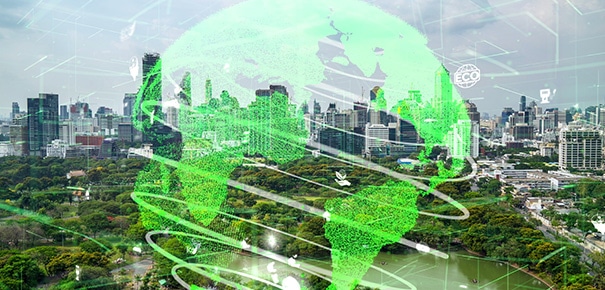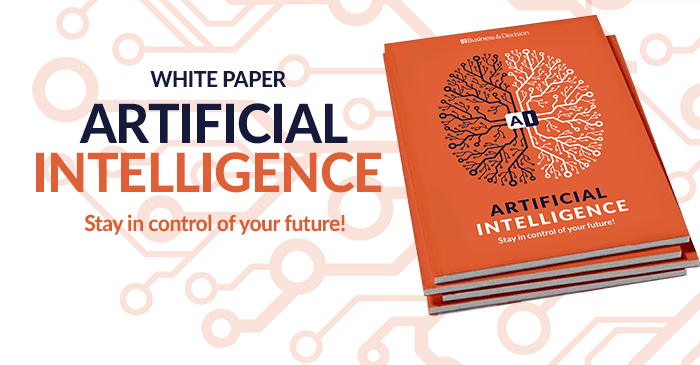When it comes to Artificial Intelligence, it’s not only about improving performance at any costs. Its benefits along its adoption requires AI to be responsible by also including an environmental side.
Taking environmental issues into account is no longer an option. The IPCC’s April 2022 report is clear. It is also, pun unintended, one of the priority themes identified by Business & Decision in the 2022 edition of its 7 hot topics. But how to reconcile technological innovation with frugality? Well, some avenues are already being explored. And no, no-one will ask you to unplug everything and give up on business transformation.
Innovation and environment are not irreconcilable. Whilst embarking on their digital transformation journeys, organizations are also trying to assume environmental responsibility and include sustainable measures as part of the change. The digital sphere is being called upon to embrace the ecological awareness movement too.
AI can be frugal and participate in companies’ digital sobriety efforts.
A balance to strike between performance & frugality
Digital sobriety is not mere wishful thinking. It involves concrete measures and can be demonstrated, thus measured. Although itself a source of CO2 emissions, the digital industry also helps reduce the environmental impact in several fields, such as semiconductors. One example being Apple’s latest M1 processors which, at equal processing power, consume five times less energy than an Intel chip.
Artificial intelligence is no exception. In fact, it may actually be a perfect illustration of this. Whether it be during learning or execution, artificial intelligence models consume energy. Sometimes a lot of it. Complexity is usually synonymous to high energy bills.
According to figures from a CNRS blog article entitled “Consommation énergétique de l’utilisation de l’IA” (AI use power consumption), emissions associated with convolutional neural networks training range from 18kg CO2-eq to 284T CO2-eq. For a standard model, without any specific configuration, this number can be as high as 652kg CO2-eq – the equivalent of a flight between Paris and Hong Kong, or a 2,500 kilometres car ride.
The adoption of artificial intelligence is set to experience strong growth in coming years. In 2021, IDC valued the global enterprise AI market at 341.8 billion dollars. In 2022, this spending is expected to increase by 18.8%. Designing the least energy-intensive AI systems possible is therefore crucial.
Because AI can be frugal and hence, participate in companies’ digital sobriety efforts. However, this requires willpower, and above all concrete actions such as a method. Even if the subject is still an emerging one, we should already start adopting best practices. Otherwise, Green AI will be just another acronym on the market and in the greenwashing discourse.
Energy consumption is part of AI ethics
AI’s environmental footprint is a factor that must be taken into account. And it is not the only one. Green AI is part of the broader approach that is responsible artificial intelligence. Responsibility should be determined and acted upon at several levels, and during the different phases, of a project. But to do so, it is essential to raise awareness amongst all payers involved in the AI development chain, Data Scientists and Data Engineers , as well as project managers and business sponsors.
When it comes to artificial intelligence, fully embracing frugality means factoring it in the thinking right from the ideation and qualification phases. Which data to exploit for the model? Do the datasets include personal data? If yes, can it be anonymised or, at least pseudonymised?
A responsible AI development approach also ensures that past abuses associated with mass personal data exploitation are not repeated. Responsible AI also minimises negative externalities and tries to limit and correct biases. Ethics committees are one way in which to take into account these different issues and ensure the setup of effective control measures.
AI energy frugality and ethics are in accord regarding another aspect: performance, or more specifically its trade-off. A more complex model can help improve performance. But will also adversely affect explainability. The same applies to energy consumption.
Deep Learning or Machine Learning: the responsible trade-off
Complexity goes hand in hand with increased CO2 emissions. Neural networks are not the be-all and end-all of artificial intelligence and there is something to be said for simplicity in more cases than one. Deep Learning is not a “cure-all” solution for Data Scientists, who sometimes take the easy way out by systematically resorting to it.
In fact, Deep Learning proves too often to be an energy sink, namely due to the huge amount of data required for learning. And the availability of computing power (GPU and TPU) only further encourages its practice. The application of Deep Learning is justified for clearly identified use cases, such as image, voice or speech recognition.
If companies cannot do without AI (assuming they have found it to be useful), then they bear a responsibility to reduce its impacts, including on the environment.
But the tendency to blindly resort to neural networks for simple and structured types of data, which in fact constitutes the vast majority of use cases, is pure mismanagement.
AI producers and consumers have a role to play by deciding, upstream, to invest their time and resources, namely in data selection and preparation. This mindset is key to making responsible artificial intelligence a reality. If companies cannot do without AI (assuming they have found it to be useful), then they bear a responsibility to reduce its impacts, including on the environment.
Responsible AI methodology and governance
This leaves us with the how question. It is all about the AI model’s design, the choice of its type, and actions taken at the operational level, such as the frequency of AI execution and training, and even code optimisation. The carbon footprint can be reduced by opting for greener Data Centres for storage and computation during execution and learning. Preferring Edge Computing to big Data Centres would also be a good idea. This helps decentralise processing and only centrally transmit useful information.
FinOps, a tool initially developed to control cloud billing, can also contribute to the reduction of the carbon footprint by limiting resources consumption and promoting the adoption of sobriety-friendly practices, both on the financial and energy fronts.
It is important to include frugality in AI ethics committees’ roadmaps. This is why Business & Decision has developed a methodology to ensure that companies equip themselves with AI that is both efficient and responsible. Our aim is to help them audit their models with a view to tending towards responsible AI.
AI for Green: when Artificial Intelligence is supporting environment
We firmly believe that Green AI is possible. But also firmly believe in AI for Green, i.e. that artificial intelligence can be used to help the environment. Orange, a group that we are part of and to which we have provided support, is a perfect example of this. The operator uses AI to detect antenna operation failures and dispatch repair service teams. A level of responsiveness that has helped reduce its mobile network’s CO2 emissions by15% in one year.
Use cases such as this one are manifold, namely in the smart building field. The development of IoT and sensors supports these AI applications by making data collection and forecasts possible.
Supply chain and delivery routes optimisation using AI also helps reduce the carbon footprint. The potential is also there in the agricultural sector where predictive and image analysis models contribute to the optimisation of various tasks, such as irrigation or plot treatment, which can as a result be more targeted.
In the energy sector, industrialists are collaborating to design models that will increase the output of the French wind farm whilst minimising noise pollution for neighbouring homes.
Artificial intelligence also directly contributes to environment preservation by, for example, helping to protect corals and detect plastic waste in the oceans. AI is at the heart of a project like CORail, which combines image analysis and algorithms.
There is a wealth of possibilities reminding us that even though AI is a CO2 emitter, it is also part of the solution to the climate crisis.
















Your email address is only used by Business & Decision, the controller, to process your request and to send any Business & Decision communication related to your request only. Learn more about managing your data and your rights.